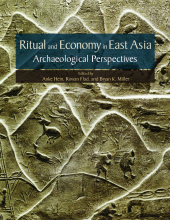
Latest Publications, New
Series: Ideas, Debates, and Perspectives
ISBN: 978-1-950446-40-7 (print), 978-1-950446-41-4 (eBook)
Publication Date: July 1, 2023
Price: Hb $100, eBook $80
Order this book here!
- Print: Order from our distributor
In commemoration of Lothar von Falkenhausen’s 60th birthday, this volume assembles eighteen scholarly essays that explore the intersection between art, economy, and ritual in ancient East Asia. The contributions are clustered into four themes: “Ritual Economy,” “Ritual and Sacrifice,” “Technology, Community, Interaction,” and “Objects and Meaning,” which collectively reflect the theoretical, methodological, and historical questions that Falkenhausen has been examining via his scholarship, research, and teaching throughout his career.

Most of the chapters work with archaeological and textual data from China, but there are also studies of materials from Mongolia, Korea, Southeast Asia and even Egypt, showing the global impact of Falkenhausen’s work. The chronological range of studies extends from the Neolithic through the Bronze Age in China, into the early imperial, medieval, and early modern periods. The authors discuss art, economy, ritual, interaction, and technology in the broad context of East Asian archaeology and its connection to the world beyond.

Table of Contents
Preface: To Lothar Li Shuicheng
Chapter 1 – Introduction: Ritual and Economy in East Asian Archaeology Rowan Flad and Anke Hein
Part I: Ritual Economy
Chapter 2: Uncovering Disguised Social Inequality: An Investigation of the Bronze Age Cemetery at Donghuishan Wen Chenghao
Chapter 3: On the Margins of the Chinese World: The Bronze, Iron, and Gold of the Xi Rong at Majiayuan Alain Thote
Chapter 4: Ritual Economies of Peripheral East Asia: Reflections on Mahan Mortuary Archaeology Jack Davey
Chapter 5: State Regulations or Human Sentiment: The Disappearance of Funerary Figurines in Ninth Century Chang’an and Luoyang Ye Wa
Part II: Ritual and Sacrifice
Chapter 6: No Sacrifice Too Great: A Measured Speculation on the Motive behind the Great Sanxingdui Hoards Richard Ehrich
Chapter 7: Raw Material Hoards, Ritual Deposits, or Disturbed Burials? Object Pits in the Mountains of Southwest China Anke Hein
Chapter 8: The Zooarchaeology of Oracle Bone Divination in Northwest China Katherine Brunson, Li Zhipeng, Rowan Flad, Qiao Hong, and Wang Qianqian
Chapter 9: Emergence of Chime-bells and Li-yue in the Zhou Dynasty Kazuo Miyamoto
Chapter 10: Consuming the Herds: Animal Sacrifice and Offerings of the Xiongnu Bryan K. Miller
Part III: Technology, Community, Interaction
Chapter 11: Long-Distance Influences and Local Adoption: Technological Innovation in Ritual and Economy in Late Prehistoric Northwest China Rowan Flad
Chapter 12: Organization of Copper Mining and Smelting along the Middle Yangzi River Shi Tao
Chapter 13: Erlitou and Nanwa: Contextualizing White Ceramics in Early Bronze Age China Lee Hsiu-ping
Chapter 14: Archaeology of Community: Changing Settlement Patterns from the Yingpanshan to the Shi’erqiao Period in Ancient Sichuan, China Lin Kuei-chen
Chapter 15: China for Asia: Bencharong and Peranakan Porcelains in the Eighteenth and Nineteenth Centuries Ellen Hsieh
Part IV: Objects and Meaning
Chapter 16: The Xi’an Kharoṣṭhī Inscription: A New Translation Minku Kim
Chapter 17: Solidified Qi Clouds: Reconsideration of the Form and Name of Boshan Incense Burners Zhang Hanmo
Chapter 18: “What Was the Nicest Thing You Ever Found?” An Essay on the Meaning of Objects Hans Barnard
Epilogue: The Number 60 and the Beginning of Everything Willeke Wendrich
Afterword: Lothar von Falkenhausen
